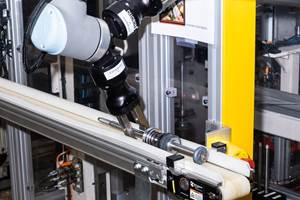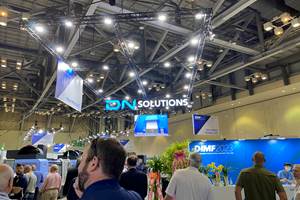It's A Machine Tool Robot
This machine has a dual identity. It looks like an industrial robot. In some applications, such as assembly, it is. However, put a spindle and cutting tool on the end of this five-axis machine and it becomes a machining and drilling center. The inherent stiffness of the machine's tripod design makes it accurate enough to machine aerospace and automotive applications.
Share






This machine has a dual identity. It looks like an industrial robot. In some applications, such as assembly, it is. However, put a spindle and cutting tool on the end of this five-axis machine and it becomes a machining and drilling center. The inherent stiffness of the machine's tripod design makes it accurate enough to machine aerospace and automotive applications.
The machine's manufacturer, Neos Robotics, (Taby, Sweden) has named it Tricept. JMC Technology Group, Inc., (Indianapolis, Indiana), is the U.S. importer for the machine. It is available in two models, the TR 600 and the new, larger TM 805.
The first version of this machine tool, the TR600, was developed about five years ago. Its original purpose was for precision assembly applications. Shortly after these machines found work in assembly, it was discovered that they could do very nicely in light milling and drilling applications especially in environments where high flexibility was a requisite.
The business end to the machine is a tripod formed by three servo actuators. These are pre-loaded to be backlash free. At the upper end, each of the three actuators is supported by a universal joint to aid in freedom of movement. At the lower end is a pre-loaded ball joint with three-degrees of freedom. The upper end of the actuators is supported by a hexagonal cast iron frame. The frame is supported by a column-like structure that is tied to the machine base. The overall machine configuration resembles the well-known C-frame machining center design.
The three actuators guide a central, rigid tube that attaches to the hexagonal frame via a universal joint in its center. A gearbox is integrated in this tube and transmits 590 ft/lbs of torque to manipulate the four or five-axis wrist. In its current design, the machine carries an Ibag 60 hp, 24,000 rpm spindle.
The high-speed spindle coupled with interpolated path speeds of 3500 ipm, facilitate high speed machining in a variety of aerospace and automotive applications. Acceleration is 2g and accuracy is 0.0004 inch. The machine uses a proprietary direct measuring system to provide positioning feedback. Working envelope for the larger machine is 98 by 98 by 31 inches.
Siemens CNC and drive systems are used on the machine. To be able to control the motion of the Tricept machine, using conventional NC programs, a real-time conversion software package has been developed. Using this conversion, the CNC understands a NC program that shows tool path and calculates the appropriate three-dimensional vector. The control software consequently handles the parameters of the machine's kinematics. Shopfloor programming changes can be done on the CNC which features a PC front end.
More applications for this machine are emerging. It has already been successfully applied in aerospace and automotive industries. Its flexibility for five-sided machining with the design's speed and rigidity make it a candidate for production applications in the power train and turbine industries as well as mold and die applications.
Just because our metalworking vernacular lacks a term that accurately describes this new machine tool, it doesn't mean the industry can't use it. A good machine, applied well, no matter what it's called, can still make a shop money.
Related Content
Eliminating Automotive Defects Per Million With Automated Visual Inspection
This automotive manufacturer virtually eliminated PPM defect complaints after implementing an automated visual inspection system at its facility.
Read MoreDN Solutions Responds to Labor Shortages, Reshoring, the Automotive Industry and More
At its first in-person DIMF since 2019, DN Solutions showcased a range of new technologies, from automation to machine tools to software. President WJ Kim explains how these products are responses to changes within the company and the manufacturing industry as a whole.
Read More6 Ways Electrification is Shifting Automotive Manufacturing
Trends to watch at IMTS: A Tier One transmission supplier weighs in on how hybrid and electric vehicles are changing the requirements for automotive component producers.
Read MoreNew Coolant Designed for Automotive Parts Production
Choosing the right coolant is critical for productivity, economic efficiency and machining quality.
Read MoreRead Next
AMRs Are Moving Into Manufacturing: 4 Considerations for Implementation
AMRs can provide a flexible, easy-to-use automation platform so long as manufacturers choose a suitable task and prepare their facilities.
Read MoreMachine Shop MBA
Making Chips and Modern Machine Shop are teaming up for a new podcast series called Machine Shop MBA—designed to help manufacturers measure their success against the industry’s best. Through the lens of the Top Shops benchmarking program, the series explores the KPIs that set high-performing shops apart, from machine utilization and first-pass yield to employee engagement and revenue per employee.
Read More




















